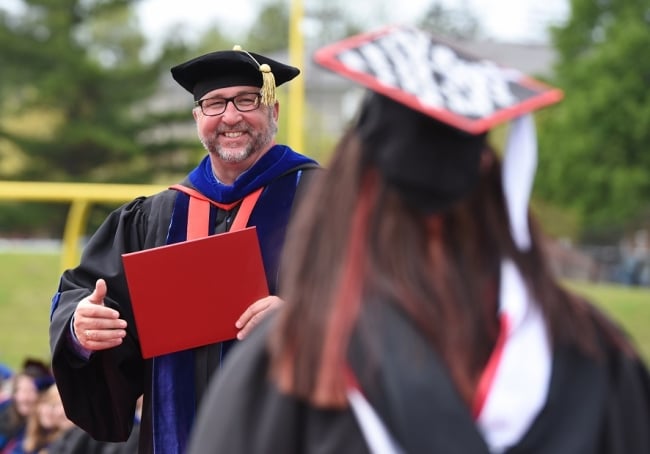You have /5 articles left.
Sign up for a free account or log in.

Michael S. Brophy stepped down Friday as Benedictine University president.
Benedictine University
Two years into Michael S. Brophy’s presidency at Benedictine University, in October, the Board of Trustees said it was reappointing him through 2022. Brophy made it 10 months and six days from the date of that announcement.
Brophy stepped down Friday, surprising higher education leaders in Illinois, where Benedictine’s main campus is located. Leaders at the small Roman Catholic institution 25 miles to the west of Chicago have been tight-lipped about the reasons for his departure, but it follows a difficult time for the university -- and for higher education in Illinois more generally.
Benedictine has been losing students for years, closing a branch campus in Illinois this spring even as enrollment at its main campus falls. A branch it opened in Mesa, Ariz., a few years ago has been growing, but not fast enough to offset drops elsewhere.
Brophy, meanwhile, took the Benedictine job under difficult circumstances. He followed a longtime president, William J. Carroll, who led the institution for two decades. And he started after a group of monks with historical ties to the institution sued it in part because they felt bylaws entitled them to more say in the presidential selection process.
It is not clear which if any of those factors played a role in Brophy’s departure. The university announced Aug. 9 that he would be stepping down, effective the next day. Classes start in just two weeks, Aug. 27. The same day the university announced Brophy was stepping down, it posted a summer 2018 update from him in which he wrote about “anticipation of the excitement that the start of a new semester brings.”
Brophy plans to take a yearlong sabbatical to research leadership in higher education, then return to teaching in 2019. He has tenure at Benedictine.
“It’s been an honor to sustain the Benedictine mission during my tenure as president. Recent developments at the university prepare Benedictine to move to the next level as a first-choice regional Catholic university as well as a thought-leader in our sector,” Brophy said in a statement accompanying the news he was leaving.
The university did not make Brophy or any board members available to comment. But negotiations regarding Brophy’s resignation started in late July, Board Chair James L. Melsa told the Daily Herald.
"Although the fall semester begins in a few weeks, we are confident in a successful transition of leadership to [interim president] Charles Gregory, who was the former Benedictine University executive vice president and recent Mesa campus CEO," Melsa told the Herald.
Brophy was credited for growing enrollment at Benedictine’s Mesa campus, introducing new online programs, developing a new mission statement, crafting a new strategic plan and creating a new facilities master plan, among other efforts. In July, the college touted being granted access to the NCAA Division II membership process as part of a strategy Brophy said was designed to distinguish Benedictine as “a first choice, Catholic, liberal arts school in the Midwest.”
Yet Benedictine has gone through its share of ups and downs in recent years. In May, it told 32 nonfaculty employees that their jobs were being eliminated, mostly because it was closing a campus in Springfield.
The campus, attended by adult degree-completion and graduate students, hadn’t hosted undergraduate programs since 2014. University leaders said it was closing because of needed capital improvements and that students would be moved to other sites.
A spokeswoman told The State Journal-Register deferred maintenance totaled about $5 million and that enrollment at the campus was low, estimated at under 100 students after May graduation. Benedictine had become involved in the campus when it partnered with Springfield College in Illinois in 2003. Benedictine took over operations in 2009.
In July, Brophy said he hoped to sell the campus for $3 million to a buyer who would use it for education.
Benedictine’s enrollment has also been steadily dropping since 2012-13. Its head count totaled 6,516 that year, the year before the new Mesa campus opened. Head count has not increased on a year-to-year basis since then. It stood at 5,101 as of 2017-18. The university ran deficits twice in the three years from 2015 to 2017.
In his summer update posted Aug. 9, Brophy wrote that overall student registrations for the new semester were on target and that both Benedictine’s main campus in Lisle and its campus in Mesa were reporting undergraduate enrollment pacing ahead of last year. He also expressed confidence about a forecast balanced budget.
Brophy started at the university at a time when it was facing challenges both internal and external. In 2015, the university was sued by monks whose religious order founded it in 1887. They said a group of seven monks were given the power to approve the selection of university president but had been denied the chance to meet finalists or approve the president in the process that ultimately selected Brophy.
“It gets to the very nature and identity of the school. It’s a Benedictine school,” said Father Austin Murphy, the abbot of St. Procopius Abbey, at the time. The abbey is part of the order that founded Benedictine. “To go in another direction is changing it in a dramatic way, and that is really an issue about our core identity.”
University leaders issued a statement at the time saying that the abbot is an ex officio member of the Board of Trustees with full voting rights on all matters. The university interpreted this to mean the abbot and his vote represented the abbey and its members but that the monks’ special governance powers were related to property sales, trustee elections, debts and university closure.
A woman answering the phone at the abbey on Friday started to take a message for Abbot Murphy. When she learned she was speaking with a reporter, she said the abbey was not commenting on the Benedictine president. She said she would still deliver a request for comment to the abbot, however.
Abbot Murphy declined comment when reached through a Facebook message.
It should be noted that Benedictine wasn’t Brophy’s first stop at a Roman Catholic institution in a time of change. He spent almost a decade at Marymount California University as it attempted to change from a two-year institution into a four-year institution with graduate programs.
Benedictine’s story also fits into a larger story of higher education in Illinois, which exports a large number of college students but is seeing the number of traditional-age students drop amid stiff demographic headwinds.
The college fits a traditional profile, said Mick Weltman, executive director of the Associated Colleges of Illinois.
“They are a traditional, independent, faith-based liberal arts college,” Weltman said.
The higher ed sector faces challenges, said David W. Tretter, president of the Federation of Independent Illinois Colleges and Universities, which represents institutions’ policy interests.
“You get away from the anchor cities, into the rural areas, and the population is slowly bleeding,” Tretter said. “It’s a numbers game.”








